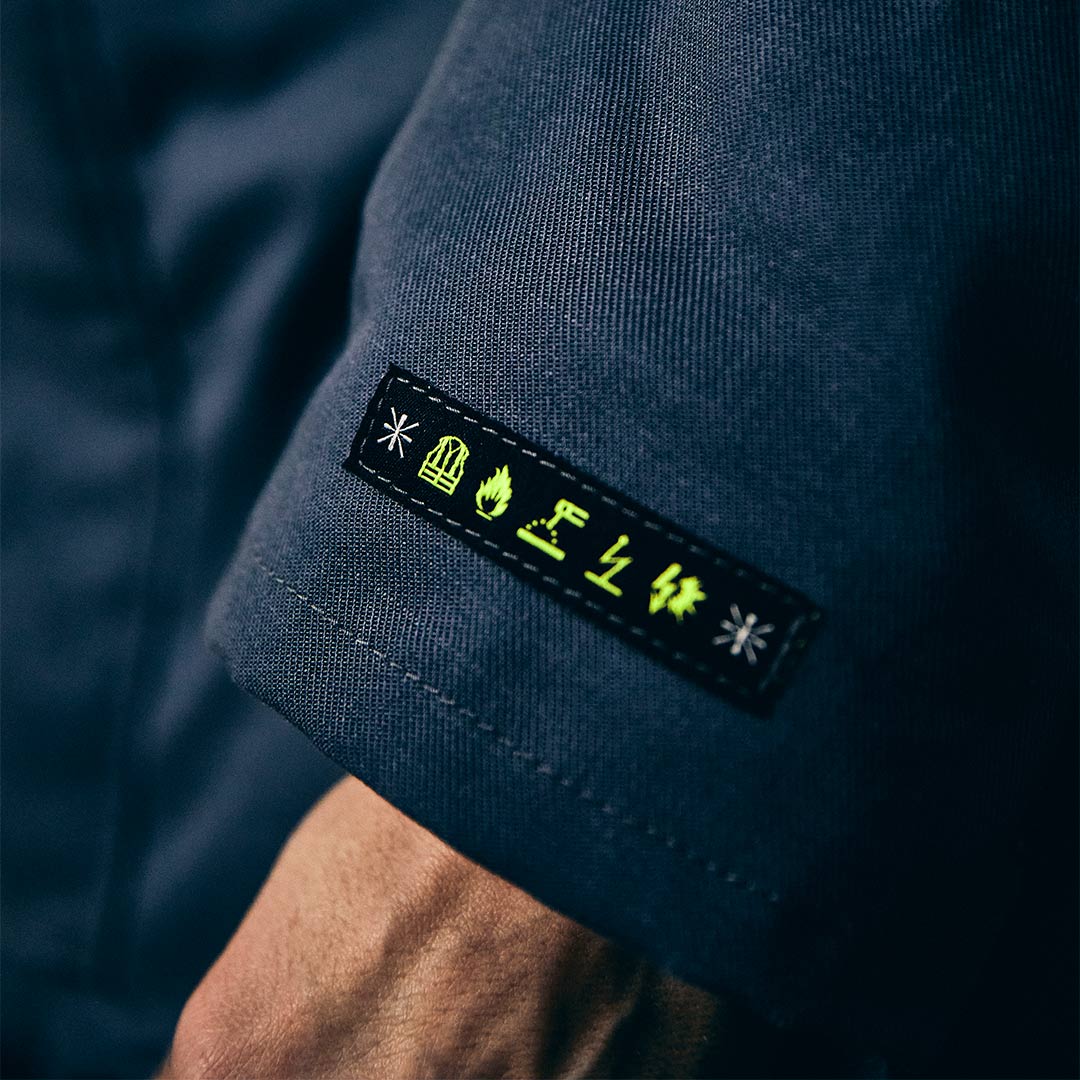
Our products meet the following safety and quality standards:
- EN ISO 13688 – General requirements for protective clothing
- EN 20471 – High visibility clothing for professional use
- EN 1149–5 – Protective clothing, electrostatic properties, material and design requirements
- EN ISO 11612 – Clothing protecting against heat and fire
- EN ISO 11611 – Protective clothing for welding and related work
- EN 13034, Type 6 – Protective clothing against liquid chemicals
- EN 342 – Clothing and garments protecting against the cold
- IEC 61482-2 / EN 61482-2 – Protective clothing against thermal hazards of electric arcs
- EN ISO 21420 – General requirements for protective gloves
- EN 388 – Protective gloves against mechanical hazards
- EN 407 – Protective gloves against thermal risks (heat and/or fire)
Example of safety clothing certification (High visibility clothing EN ISO 20471)

HEAT PROTECTIVE CLOTHING STANDARD (EN ISO 11611, EN ISO 11612) I.E. FIRE PROTECTION
Fire protection makes the fabric self-extinguishing, meaning that the fabric smothers the spark. However, this does not mean that the material is completely incombustible. Even fire-resistant fabric can develop holes or discoloration.
Fire protection can be implemented in three ways: post-treatment, fabric impregnation or inherent technology. Post-treatment involves chemical finishing, for example by spraying a fire protection liquid. In post-treated clothing, the fire protection is least durable and can be washed off. That is why Dimex clothing uses fabric impregnation and inherent technology, where the protection is “naturally” in the fiber. Fire protection cannot be washed off from clothing treated with these technologies.
Tiedostot
- 4061-eu-vaatimustenmukaisuusvakuutus-fi-sv--en
- 2334vr-eu-vaatimustenmukaisuusvakuutus-sgs-fi-sv_-eng
- 6p-eu-vaatimustenmukaisuusvakuutus-fi-sv_-eng
- 4354_eu-vaatimustenmukaisuusvakuutus-sgs-fi-sv_-eng
- 5262-EU-vaatimustenmukaisuusvakuutus-FI.SV_.ENG
- 4355y_eu-vaatimustenmukaisuusvakuutus-sgs-fi-sv_-eng
- 6415_EU-vaatimustenmukaisuusvakuutus_sgs_fi.sv_.eng
- 6124_EU-vaatimustenmukaisuusvakuutus_sgs_fi.sv_.eng
- 2183_EU-vaatimuksenmukaisuusvakuutus
- 2187-eu-vaatimustenmukaisuusvakuutus-fi.sv_.en
- 6033_6033f_eu-vaatimustenmukaisuusvakuutus-sgs-fi-sv_-eng
- 6155_-eu_vaatimustenmukaisuusvakuutus.fi_.sv_.eng
- 695-EU-vaatimustenmukaisuusvakuutus-FI.SV_.ENG
- 6148_eu-vaatimustenmukaisuusvakuutus_fi.sv_.en
- 2210-eu-vaatimustenmukaisuusvakuutus-fi-sv_-eng
- 2352_EU-vaatimuksenmukaisuusvakuutus-FI.SV_.ENG
- 6123-EU-vaatimustenmukaisuusvakuutus-FI.SV_.ENG
- 4063-eu-vaatimustenmukaisuusvakuutus-fi.sv_.en
- 2129_EU-vaatimustenmukaisuusvakuutus_sgs_fi.sv_.eng
- 2349_EU-vaatimuksenmukaisuusvakuutus-FI.SV_.ENG
- 2354_EU-vaatimuksenmukaisuusvakuutus-FI.SV_.ENG
- 4481-4484-eu-vaatimustenmukaisuusvakuutus-fi.sv_.en
- 6168_-eu_vaatimustenmukaisuusvakuutus.fi_.sv_.eng
- 6025_eu-vaatimuksenmukaisuusvakuutus-fi-sv_-eng
- 6039-6039ip-6039p-6039r_6039vr_eu-vaatimustenmukaisuusvakuutus-fi-sv_-eng
- 6360-EU-vaatimustenmukaisuusvakuutus-FI.SV_.ENG
- 6002_eu-vaatimustenmukaisuusvakuutus-sgs-fi-sv_-eng
- 2334_2334m-eu-vaatimustenmukaisuusvakuutus-sgs-fi-sv_-eng
- 6163_-eu_vaatimustenmukaisuusvakuutus.fi_.sv_.eng
- 5072-EU-vaatimustenmukaisuusvakuutus-FI.SV_.ENG
- 4061-eu-vaatimustenmukaisuusvakuutus-fi.sv_.en
- 6176-EU-vaatimustenmukaisuusvakuutus-FI.SV_.ENG
- 644_EU-vaatimuksenmukaisuusvakuutus
- 9-EU-vaatimustenmukaisuusvakuutus-FI.SV_.ENG
- 6004vr_eu-vaatimustenmukaisuusvakuutus-sgs-fi-sv_-eng
- 6004_eu-vaatimustenmukaisuusvakuutus-sgs-fi-sv_-eng
- 2250_eu-vaatimustenmukaisuusvakuutus-sgs-fi-sv_-eng
- 6063_eu-vaatimustenmukaisuusvakuutus-sgs-fi-sv_-eng
- 4338-4338r_eu-vaatimustenmukaisuusvakuutus-sgs-fi-sv_-eng
- 565_565TE-EU-vaatimustenmukaisuusvakuutus-FI.SV_.ENG
- 5940d-5940do-5940s-eu-vaatimustenmukaisuusvakuutus-fi-sv_-eng
- 6194_EU-vaatimustenmukaisuusvakuutus_sgs_fi.sv_.eng
- 6007-6007w-eu-vaatimustenmukaisuusvakuutus-sgs-fi-sv_-eng
- 2251_eu-vaatimustenmukaisuusvakuutus-sgs-fi-sv_-eng
- 3N-EU-vaatimustenmukaisuusvakuutus-FI.SV_.ENG
- 6004b_eu-vaatimustenmukaisuusvakuutus-sgs-fi-sv_-eng
- 6401_6401m-eu-vaatimustenmukaisuusvakuutus-fi-sv_-eng_-1
- 2320_EU-vaatimustenmukaisuusvakuutus_sgs_fi.sv_.eng
- 6000y_eu-vaatimustenmukaisuusvakuutus-sgs-fi-sv_-eng
- 684-eu-vaatimustenmukaisuusvakuutus-fi-sv_-eng
- 6102_eu-vaatimustenmukaisuusvakuutus-sgs-fi-sv_-eng
- 6411_EU-vaatimustenmukaisuusvakuutus_sgs_fi.sv_.eng
- 4423_eu-vaatimustenmukaisuusvakuutus-sgs-fi-sv_-eng
- 6156_-eu_vaatimustenmukaisuusvakuutus.fi_.sv_.eng
- 6177_EU-vaatimustenmukaisuusvakuutus-fi.sv_.eng
- 6431_EU-vaatimustenmukaisuusvakuutus_sgs_fi.sv_.eng
- 1968-eu-vaatimustenmukaisuusvakuutus-fi-sv_-eng
- 6434_EU-vaatimustenmukaisuusvakuutus_sgs_fi.sv_.eng
- 6059_-EU-vaatimustenmukaisuusvakuutus_-sgs_fi.sv_.eng
- 6000et_eu-vaatimustenmukaisuusvakuutus-sgs-fi-sv_-eng
- 2131l_eu-vaatimustenmukaisuusvakuutus-sgs-fi-sv_-eng
- 2206_eu-vaatimustenmukaisuusvakuutus-sgs-fi-sv_-eng
- 2335vr-eu-vaatimustenmukaisuusvakuutus-sgs-fi-sv_-eng
- 6077_EU-vaatimustenmukaisuusvakuutus_sgs_fi.sv_.eng
- 6310_EU-vaatimuksenmukaisuusvakuutus
- 5262d-5262do-eu-vaatimustenmukaisuusvakuutus-fi-sv_-eng
- 6170_-eu_vaatimustenmukaisuusvakuutus.fi_.sv_.eng
- 6330_EU-vaatimuksenmukaisuusvakuutus
- 6165_-eu_vaatimustenmukaisuusvakuutus.fi_.sv_.eng
- 5940-EU-vaatimustenmukaisuusvakuutus-FI.SV_.ENG
- 2307_-eu_vaatimustenmukaisuusvakuutus.fi_.en_.sv
- 2209-eu-vaatimustenmukaisuusvakuutus-fi-sv_-eng
- 6154_-eu_vaatimustenmukaisuusvakuutus.fi_.sv_.eng
- 6121-EU-vaatimustenmukaisuusvakuutus-FI.SV_.ENG
- 6005-6005b-6005y-eu-vaatimustenmukaisuusvakuutus-sgs-fi-sv_-eng
- 6099-6099E_EU-vaatimustenmukaisuusvakuutus_sgs_fi.sv_.eng
- 6001h_eu-vaatimustenmukaisuusvakuutus-sgs-fi-sv_-eng
- 6220_EU-vaatimuksenmukaisuusvakuutus
- 6433_EU-vaatimustenmukaisuusvakuutus_sgs_fi.sv_.eng
- 2301-eu-vaatimustenmukaisuusvakuutus-fi-sv_-eng
- 6116-eu-vaatimustenmukaisuusvakuutus-fi-sv_-eng
- 6412_EU-vaatimustenmukaisuusvakuutus_sgs_fi.sv_.eng
- 6038-6038p-eu-vaatimustenmukaisuusvakuutus-sgs-fi-sv_-eng
- 1966-eu-vaatimustenmukaisuusvakuutus-fi-sv_-eng
- 6210_EU-vaatimuksenmukaisuusvakuutus
- 539TE-EU-vaatimustenmukaisuusvakuutus-FI.SV_.ENG
- 2260_eu-vaatimustenmukaisuusvakuutus-sgs-fi-sv_-eng
- 6031sm_eu-vaatimustenmukaisuusvakuutus-sgs-fi-sv_-eng
- 6072-EU-vaatimustenmukaisuusvakuutus-FI.SV_.ENG
- 2303_eu-vaatimustenmukaisuusvakuutus-sgs-fi-sv_-eng
- 6178_EU-vaatimustenmukaisuusvakuutus-fi.sv_.eng
- 6100_eu-vaatimustenmukaisuusvakuutus-sgs-fi-sv_-eng
- 6413_EU-vaatimustenmukaisuusvakuutus_sgs_fi.sv_.eng
- 6011t-eu-vaatimustenmukaisuusvakuutus-fi-sv_-eng
- 6066_EU-vaatimustenmukaisuusvakuutus_sgs_fi.sv_.eng
- 6034-6034h_-eu-vaatimuksenmukaisuusvakuutus-fi-sv_-eng
- 6436_EU-vaatimustenmukaisuusvakuutus_sgs_fi.sv_.eng
- 2130_EU-vaatimustenmukaisuusvakuutus_sgs_fi.sv_.eng
- 6014-eu-vaatimustenmukaisuusvakuutus-fi.sv_.en
- 2317_-EU-vaatimustenmukaisuusvakuutus_-sgs_fi.sv_.eng
- 6020_eu-vaatimustenmukaisuusvakuutus-sgs-fi-sv_-eng
- 6004y_eu-vaatimustenmukaisuusvakuutus-sgs-fi-sv_-eng
- 6004t_eu-vaatimustenmukaisuusvakuutus-sgs-fi-sv_-eng
- 4154-4219-4286-eu-vaatimustenmukaisuusvakuutus-fi.sv_.en
- 6164_-eu_vaatimustenmukaisuusvakuutus.fi_.sv_.eng
- 4248-4295-4428_eu-vaatimustenmukaisuusvakuutus-fi.sv_.en
- 6407-eu-vaatimustenmukaisuusvakuutus-fi-sv_-eng
- 2350_EU-vaatimuksenmukaisuusvakuutus-FI.SV_.ENG
- 6414_EU-vaatimustenmukaisuusvakuutus_sgs_fi.sv_.eng
- 4058-4059-4235-447_eu-vaatimustenmukaisuusvakuutus-fi.sv_.en
- 6010_-eu_vaatimustenmukaisuusvakuutus.fi_.en_.sv
- 6067_EU-vaatimustenmukaisuusvakuutus_sgs_fi.sv_.eng
- 5072lb-5072lt-eu-vaatimustenmukaisuusvakuutus-fi-sv_-eng
- 2212-eu-vaatimustenmukaisuusvakuutus-fi-sv_-eng
- 6000h_eu-vaatimustenmukaisuusvakuutus-sgs-fi-sv_-eng
- 6048_eu-vaatimustenmukaisuusvakuutus-sgs-fi-sv_-eng
- 2302-eu-vaatimustenmukaisuusvakuutus-fi-sv_-eng
- 6101_eu-vaatimustenmukaisuusvakuutus-sgs-fi-sv_-eng
- 2308_-eu_vaatimustenmukaisuusvakuutus.fi_.en_.sv
- 6013l-eu-vaatimustenmukaisuusvakuutus-fi-sv_-eng
- 2306_-eu_vaatimustenmukaisuusvakuutus.fi_.en_.sv
- 6403-eu-vaatimustenmukaisuusvakuutus-fi-sv_-eng
- 6032_eu-vaatimustenmukaisuusvakuutus-sgs-fi-sv_-eng
- 2131_EU-vaatimustenmukaisuusvakuutus_sgs_fi.sv_.eng
- 2299-eu-vaatimustenmukaisuusvakuutus-fi-sv_-eng
- 6000vr_eu-vaatimustenmukaisuusvakuutus-sgs-fi-sv_-eng
- 2207-eu-vaatimustenmukaisuusvakuutus-fi-sv_-eng
- 648_EU-vaatimuksenmukaisuusvakuutus
- 2300-eu-vaatimustenmukaisuusvakuutus-fi-sv_-eng
- 2188-eu-vaatimustenmukaisuusvakuutus-fi.sv_.en
- 6134_EU-vaatimustenmukaisuusvakuutus-fi.sv_.eng
- 5092lb-5092lt-eu-vaatimustenmukaisuusvakuutus-fi-sv_-eng
- 6012_EU-vaatimuksenmukaisuusvakuutus
- 2335_2335m-eu-vaatimustenmukaisuusvakuutus-sgs-fi-sv_-eng
- 5352_EU-vaatimuksenmukaisuusvakuutus
- 646_EU-vaatimuksenmukaisuusvakuutus
- 6001y_eu-vaatimustenmukaisuusvakuutus-sgs-fi-sv_-eng
- 6021_eu-vaatimuksenmukaisuusvakuutus-fi-sv_-eng
- 6003ym_eu-vaatimustenmukaisuusvakuutus-sgs-fi-sv_-eng
- 6370-EU-vaatimustenmukaisuusvakuutus-FI.SV_.ENG
- 5092-EU-vaatimustenmukaisuusvakuutus-FI.SV_.ENG
- 2351_EU-vaatimuksenmukaisuusvakuutus-FI.SV_.ENG
- 4124-eu-vaatimustenmukaisuusvakuutus-fi.sv_.en
- 645_EU-vaatimuksenmukaisuusvakuutus
- 6142_eu-vaatimustenmukaisuusvakuutus_fi.sv_.en
- 6013-EU-vaatimustenmukaisuusvakuutus-FI.SV_.ENG
- 6024-6024l_eu-vaatimuksenmukaisuusvakuutus-fi-sv_-eng
- 6001et_eu-vaatimustenmukaisuusvakuutus-sgs-fi-sv_-eng
- 6003-6003y-eu-vaatimustenmukaisuusvakuutus-sgs-fi-sv_-eng
- 6185_-eu_vaatimustenmukaisuusvakuutus.fi_.sv_.eng
- 6184_-eu_vaatimustenmukaisuusvakuutus.fi_.sv_.eng
- 2130l_eu-vaatimustenmukaisuusvakuutus-sgs-fi-sv_-eng
- 6405-eu-vaatimustenmukaisuusvakuutus-fi-sv_-eng
- 2178-EU-vaatimustenmukaisuusvakuutus-FI.SV_.ENG
- 6000_eu-vaatimustenmukaisuusvakuutus-sgs-fi-sv_-eng
- 6001_eu-vaatimustenmukaisuusvakuutus-sgs-fi-sv_-eng
- 6046_EU-vaatimuksenmukaisuusvakuutus
- 6000b_eu-vaatimustenmukaisuusvakuutus-sgs-fi-sv_-eng
- 6112_EU-vaatimustenmukaisuusvakuutus_sgs_fi.sv_.eng
- 6435_EU-vaatimustenmukaisuusvakuutus_sgs_fi.sv_.eng
- 2339-eu-vaatimustenmukaisuusvakuutus-fi-sv_-eng
- 6240-EU-vaatimustenmukaisuusvakuutus-FI.SV_.ENG
- 6006_-eu_vaatimustenmukaisuusvakuutus.fi_.en_.sv
- 10-EU-vaatimustenmukaisuusvakuutus-FI.SV_.ENG
- 2304_eu-vaatimustenmukaisuusvakuutus-sgs-fi-sv_-eng
- 6001b_eu-vaatimustenmukaisuusvakuutus-sgs-fi-sv_-eng
- 6103_eu-vaatimustenmukaisuusvakuutus-sgs-fi-sv_-eng
- 6175-EU-vaatimustenmukaisuusvakuutus-FI.SV_.ENG
- 6115-eu-vaatimustenmukaisuusvakuutus-fi-sv_-eng
- 6432_EU-vaatimustenmukaisuusvakuutus_sgs_fi.sv_.eng
- 2353_EU-vaatimuksenmukaisuusvakuutus-FI.SV_.ENG
- 1528-eu-vaatimustenmukaisuusvakuutus-fi-sv_-eng
- 6075-EU-vaatimustenmukaisuusvakuutus-FI.SV_.ENG
- 6031_eu-vaatimustenmukaisuusvakuutus-sgs-fi-sv_-eng
- 4281-eu-vaatimustenmukaisuusvakuutus-fi-sv_-eng
- 6011-eu-vaatimustenmukaisuusvakuutus-fi-sv_-eng
- 2305_eu-vaatimustenmukaisuusvakuutus-sgs-fi-sv_-eng
- 6031h-eu-vaatimustenmukaisuusvakuutus-fi-sv_-eng
- 6404-eu-vaatimustenmukaisuusvakuutus-fi-sv_-eng
- 6133_EU-vaatimustenmukaisuusvakuutus-fi.sv_.eng
- 2348p-eu-vaatimustenmukaisuusvakuutus-fi-sv_-eng
- 7p-eu-vaatimustenmukaisuusvakuutus-fi-sv_-eng
- 7100_-EU_vaatimustenmukaisuusvakuutus.FI_.SV_.ENG
- 8581l-eu-vaatimustenmukaisuusvakuutus-fi-sv_-eng
- 6320_EU-vaatimuksenmukaisuusvakuutus
- 8321_EU-vaatimustenmukaisuusvakuutus_sgs_fi.sv_.eng
- 7001_-EU_vaatimustenmukaisuusvakuutus.FI_.SV_.ENG
- 6439_EU-vaatimustenmukaisuusvakuutus_sgs_fi.sv_.eng
- 2211-eu-vaatimustenmukaisuusvakuutus-fi-sv_-eng
- 6740_EU-vaatimuksenmukaisuusvakuutus
- 6437_EU-vaatimustenmukaisuusvakuutus_sgs_fi.sv_.eng
- 60191_EU-vaatimuksenmukaisuusvakuutus.FI_.SV_.ENG
- vr1n-eu-vaatimustenmukaisuusvakuutus-fi-sv_-eng
- 7200_-EU_vaatimustenmukaisuusvakuutus.FI_.SV_.ENG
- 6700-EU-vaatimustenmukaisuusvakuutus-FI.SV_.ENG
- 15281-eu-vaatimustenmukaisuusvakuutus-fi-sv_-eng
- 6441_EU-vaatimustenmukaisuusvakuutus_sgs_fi.sv_.eng
- 60211-60211k-eu-vaatimustenmukaisuusvakuutus-fi-sv_-eng
- 60226022p_eu-vaatimuksenmukaisuusvakuutus-fi-sv_-eng
- vr2n-eu-vaatimustenmukaisuusvakuutus-fi-sv_-eng
- vr5n-eu-vaatimustenmukaisuusvakuutus-fi-sv_-eng
- 6438_EU-vaatimustenmukaisuusvakuutus_sgs_fi.sv_.eng
- 7101_-EU_vaatimustenmukaisuusvakuutus.FI_.SV_.ENG
- 60356035t_eu-vaatimuksenmukaisuusvakuutus-fi-sv_-eng
- 60366036l_eu-vaatimuksenmukaisuusvakuutus-fi-sv_-eng
- vr4n-eu-vaatimustenmukaisuusvakuutus-fi-sv_-eng
- 6340_EU-vaatimuksenmukaisuusvakuutus
- 6406-eu-vaatimustenmukaisuusvakuutus-fi-sv_-eng
- 6122-EU-vaatimustenmukaisuusvakuutus-FI.SV_.ENG
- 4355r_eu-vaatimustenmukaisuusvakuutus-sgs-fi-sv_-eng
- 18121-EU-vaatimustenmukaisuusvakuutus-FI.SV_.ENG
- 6015_EU-vaatimuksenmukaisuusvakuutus
- 6350-EU-vaatimustenmukaisuusvakuutus-FI.SV_.ENG
- 6069_eu-vaatimustenmukaisuusvakuutus-sgs-fi-sv_-eng_-1
- 6410-EU-vaatimustenmukaisuusvakuutus-FI.SV_.ENG
- 6085_EU-vaatimustenmukaisuusvakuutus_sgs_fi.sv_.eng
- 6098_EU-vaatimustenmukaisuusvakuutus_sgs_fi.sv_.eng
- 7000_-EU_vaatimustenmukaisuusvakuutus.FI_.SV_.ENG
- 2208-eu-vaatimustenmukaisuusvakuutus-fi-sv_-eng
- 688_EU-vaatimuksenmukaisuusvakuutus
- 6076-EU-vaatimustenmukaisuusvakuutus-FI.SV_.ENG
- 6402_6402m-eu-vaatimustenmukaisuusvakuutus-fi-sv_-eng
- 2191-eu-vaatimustenmukaisuusvakuutus-fi-sv_-eng
- 60381-60381r-60381t_eu-vaatimustenmukaisuusvakuutus-sgs-fi-sv_-eng
- 6490_EU-vaatimuksenmukaisuusvakuutus
- 6050_6050l_eu-vaatimustenmukaisuusvakuutus-sgs-fi-sv_-eng
- 11P_EU-vaatimustenmukaisuusvakuutus_sgs_fi.sv_.eng